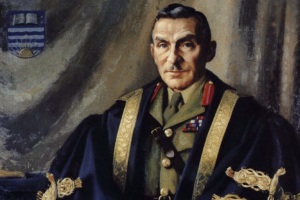
“I know of no Canadian who has served his country in war and peace with greater distinction and more unselfishly” – Prime Minister Lester B. Pearson Sherwood Lett was a decorated veteran of the First and Second World War, Chancellor of UBC from 1951 to 1957, Chief Justice of the BC Supreme Court from 1955 to 1963, and Chief Justice of the BC Court of Appeal for a short time before his death in 1964.
While Chancellor of UBC, he also served as a Canadian representative on the International Control Commission overseeing the withdrawal of French forces from North Vietnam.
A member of UBC’s Class of 1916, Sherwood Lett was one of the University’s very first graduates, and took an active, lifelong interest in his alma mater's growth and development. During his time as a student he helped draft the constitution of the Alma Mater Society (AMS). Though amended over time to reflect changing student concerns, a century later it still forms the basis of student government at UBC. Lett was elected as the first president of the AMS by a unanimous vote of the student body.
His involvement in UBC continued through his later roles as a founder of the Alumni Association, a UBC Senator for thirty-three years, a member of the Board of Governors, and finally as Chancellor. He was instrumental in numerous physical and academic expansions of the university, including the establishment of the Faculty of Law in 1945.
In his judicial career, Lett’s greatest legacy was most likely his judgement in the BC Electric case, which at the time raised novel constitutional issues. Lett declared provincial legislation expropriating BC Electric to be ultra vires, prompting renegotiation and a substantially increased price for acquisition of the company by the province.
In a ceremony in 1945, the year in which the Faculty of Law was established, Lett was recognized as follows for his contributions: “Mr. Chancellor, I have the honour to present for the degree of Doctor of Laws, honoris causa, Sherwood Lett, jurist and soldier active and distinguished in two world wars; one of the organizers and leaders of an heroic military adventure, and decorated for gallantry therein; alumnus with a long record of unsparing devotion to this University.”
Below are excerpts from a biography of Lett’s life:
“It seemed that even before he returned home [from the First World War] he had decided to study law. At least two of the senior officers in his battalion were lawyers, and this may have had an influence on him. There was no Faculty of Law at the University of British Columbia, so the normal practice was either to enroll in a law faculty in a university outside British Columbia and get a degree there, or article as a student with a law firm within the province. If one did not have a university degree, a student could anticipate being an articled student for five years before taking the law examinations and being called and admitted to the Bar. With a university degree, one could go through the same process in half the time. Before the war it was not uncommon for an articled student to pay a law firm a symbolic one dollar for the privilege of the experience the law firm would give him. At the same time he was expected to undertake a considerable amount of legal clerical work for the firm. The shortage of manpower during the war was one factor which helped to change this situation. Nevertheless, when Sherwood applied for and was accepted as an articled student under Albert N. Daykin, of Daykin and Burnett, his pay was only $40 per month” (Roy, 52). “Only in the latter part of the 1930s was the university’s grant from the province slowly increased, and even as late as 1937-8 it was only $400,000 (with a student enrolment of over 2,000). Several proposals which Sherwood suggested during this period, for example, were turned down owing to fiscal limitations. For many years Sherwood had favoured the idea, proposed by the benchers as early as 1922, of establishing a Faculty of Law at the university. Late in 1938 Sherwood, representing the Board, and his good friend, Arthur Lord, representing the Senate, once again presented a statement to Senate favouring the representation of the Law Society of British Columbia that such a faculty be established” (Roy, 91). “Even before Sherwood was retired from the army, he was asked by the Treasurer of the Law Society to be a member of a committee ‘to expedite the establishment of a Faculty of Law’ at UBC.…There was a certain urgency about the matter as well. The [Second World War] was coming to an end, and close to a million veterans would be seeking to re-establish themselves in civil life. The federal government had promised to support those seeking a university education, and there was no doubt that, among the professions, many would choose a career in law. Thus while Sherwood and Arthur Lord supported the move in Senate to establish a law faculty, both worked equally hard as benchers to promote it. It called for a lot of co-operation by many individuals, but by the time the university classes began in the autumn of 1945, the first law students were enrolled. A month later, the Chief Justice of the Supreme Court of BC, R.H. Tupper, and Sherwood were appointed to be conjoint examiners with the faculty at UBC” (Roy, 122).
The Allard School of Law would like to extend its appreciation to Sherwood Lett’s granddaughter who attended the 2016 spring convocation celebration at Allard Hall to promote her grandfather’s book to graduates, alumni and friends of the law school.
For more, read the full text of Reginald H. Roy's Sherwood Lett: His Life and Times (Vancouver: UBC Alumni Association, 1991).
First published on July 14, 2016.